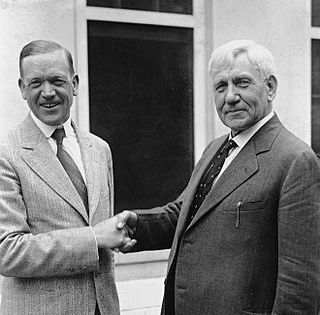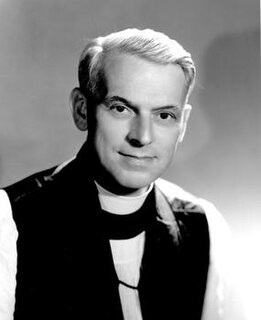Related Research Articles

Sigma Pi (ΣΠ) is collegiate fraternity with 233 chapters at American universities. As of 2021 the fraternity had more than 5,000 undergraduate members and more than 110,000 alumni.
The Foreign Agricultural Service (FAS) is the foreign affairs agency with primary responsibility for the United States Department of Agriculture's (USDA) overseas programs — market development, international trade agreements and negotiations, and the collection of statistics and market information. It also administers the USDA's export credit guarantee and food aid programs and helps increase income and food availability in developing nations by mobilizing expertise for agriculturally led economic growth. The FAS mission statement reads, "Linking U.S. agriculture to the world to enhance export opportunities and global food security," and its motto is "Linking U.S. Agriculture to the World."

The McNary–Haugen Farm Relief Act, which never became law, was a controversial plan in the 1920s to subsidize American agriculture by raising the domestic prices of farm products. The plan was for the government to buy the wheat and then store it or export it at a loss. It was co-authored by Charles L. McNary (R-Oregon) and Gilbert N. Haugen (R-Iowa). Despite attempts in 1924, 1926, 1927, and 1931 to pass the bill, it was vetoed by President Calvin Coolidge, and not approved. It was supported by Secretary of Agriculture Henry Cantwell Wallace and Vice President Charles Dawes.
The Agricultural Trade Development and Assistance Act of 1954 is a United States federal law that established Food for Peace, the primary and first permanent US organization for food assistance to foreign nations. The Act was signed into law on July 10, 1954, by President Dwight D. Eisenhower.
In different administrative and organizational forms, the Food for Peace program of the United States has provided food assistance around the world for more than 50 years. Approximately 3 billion people in 150 countries have benefited directly from U.S. food assistance. The Office of Food for Peace within the United States Agency for International Development (USAID) is the U.S. Government's largest provider of overseas food assistance. The food assistance programming is funded primarily through the Food for Peace Act. The Office of Food for Peace also receives International Disaster Assistance Funds through the Foreign Assistance Act (FAA) that can be used in emergency settings.

Hugh Wilson "Bones" Taylor was an American football player and coach. He played as an end in the National Football League (NFL) for the Washington Redskins. Taylor attended Tulane University at the start of World War II where he was a Navy V-12 student. At Tulane he was an All-Southeastern Conference and All-American basketball player in 1943. After being discharged from the U.S. Navy in 1946, he played college football at Oklahoma City College before entering the NFL in 1947. In his first NFL game, he gained 212 yards receiving, setting league records for an NFL debut and first game of the season. Those records were broken by Anquan Boldin in 2003 and Frank Clarke in 1962, respectively. As a member of the Redskins from 1947 to 1954, the 6-foot-4-inch Taylor made the Pro Bowl in 1952 and 1954.
Joseph Ray Laws was an American football player. He played his entire career with the Green Bay Packers, winning three World Championships, and was inducted into the Green Bay Packers Hall of Fame in 1972. Prior to joining the Packers, Laws attended the University of Iowa where he was a member of Sigma Pi fraternity. While at Iowa he was named All-Big Ten quarterback and the Big Ten Most Valuable Player in 1933. On December 17, 1944 Joe Laws set an NFL postseason record, by intercepting 3 passes in the Packers' 14-7 victory over the Giants in the league title game.

Arthur Carl Lichtenberger was a bishop of the Episcopal Church in the United States. He served as Bishop of Missouri from 1952 to 1959, and as Presiding Bishop of the Episcopal Church from 1958 to 1964.
William Hazell Jr. was the fifth President of the New Jersey Institute of Technology (NJIT) from 1970 until 1975.
Waldo Wilbert Wegner was an American basketball player. Wegner was the first NCAA All-American in Iowa State basketball history. Standing 6'4", Wenger was a civil engineering student at Iowa State when he answered an advertisement in the college newspaper to try out for the team.
Robert Leonard Larson was a Justice of the Iowa Supreme Court from February 9, 1953 to April 1, 1971, appointed from Johnson County, Iowa. He was previously Attorney General of Iowa from 1947 to 1953.
Arthur Raymond McKinstry was the American bishop of the Episcopal Diocese of Delaware from 1939 to 1954. He was elected November 15, 1938; consecrated February 17, 1939; and retired on December 31, 1954.

Rose Hill Farmstead, also known as the Rose—Wise—Patterson Farm, was a historic home and farm located near Vincennes in Palmyra Township, Knox County, Indiana. The original farmhouse as built in 1807 by Martin Rose. This house was replaced in 1827 by a two-story, Federal style brick I-house which was built by Rose's son, Matthias Rose. It had a rear ell added in 1829 and was remodeled about 1890. Also on the property were a contributing silo, summer kitchen, two barns, garage chicken coop, and tool or storage shed. It has been demolished.
George Dinsmore Stoddard was the president of University of Illinois and the University of the State of New York. He was also the chancellor of New York University and Long Island University.
Émile Bials De Sauzé was a French born naturalized-American language educator who developed the Cleveland Plan for teaching foreign languages. He is credited with originating the conversational method where students hear a teacher speak a word, then write it, then speak it. This method replaced the older method of simply memorizing words and grammar.

Raymond Oscar Evans was a widely circulated American editorial cartoonist who was active from 1910 to 1954. He is best known for his cartoons entitled The Americanese Wall – As Congressman Burnett would build it and It’s Going To Be Just Turned Around, both dealing with immigration.
Isaac Kelley Beckes was the president of Vincennes University from 1950 to 1980. Before going to Vincennes he was the Executive Secretary of the United Christian Youth Movement. He is considered one of the initial leaders of a nationwide educational movement to add occupational programs alongside college transfer programs at two-year post-secondary institutions. He was also the first president of a two-year college to gain an exemption from the North American Interfraternity Conference and have national fraternities established at his school.
Garfield Vestal Cox was a leading authority on business fluctuations and forecasting. He was one of the first people to study the performance of experts versus novices in forecasting stock prices. He was also the Dean of the University of Chicago School of Business.
Fred Everett Roberts was an American football player. He played college football for the University of Iowa where he was a member of Sigma Pi fraternity, vice president of the junior class, and a member of the track team. In 1928 and 1929 he was voted All-Big Ten and in 1929 was voted a United Press All-American. In the National Football League (NFL), he played as a guard for the Portsmouth Spartans from 1930 to 1932. He appeared in 26 NFL games, 16 as a starter.
References
- 1 2 3 4 5 "Gwynn Garnett Dies". The Washington Post. Washington, DC. November 23, 1995. Retrieved November 20, 2020.
- 1 2 3 Mustard, Allen (May 2003). "An Unauthorized History of the FAS". The Foreign Service Journal. Vol. 80 no. 5. pp. 38–39.
- 1 2 Swanson, Ryan (March 2003). "The History of the Foreign Agricultural Service: Helping U.S. Producers Feed, Clothe and House the World" (PDF). Library of Congress. p. 5.
- ↑ Foster, Bill (November 1932). "Sigma". The Emerald of Sigma Pi. Vol. 19 no. 3. pp. 141–142. Retrieved November 20, 2020.
- ↑ The Bomb Yearbook. Iowa State University. 1933. p. 105. Retrieved November 25, 2020.
- ↑ Murphy, Richard O. (November 1937). "Sigma". The Emerald of Sigma Pi. Vol. 24 no. 3. p. 133. Retrieved November 20, 2020.
- ↑ Truelsen, Stewart (March 21, 2018). "American Farm Bureau: A Longtime Champion for Trade". American Farm Bureau.
- ↑ Keller, Bill (October 31, 1984). "Raising All Natural Beef: Hardy Few Deliver Goods". The New York Times. New York, NY. Retrieved November 20, 2020.
- ↑ "Gwynn Garnett". FindAGrave.com.